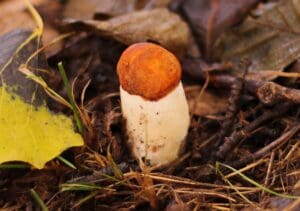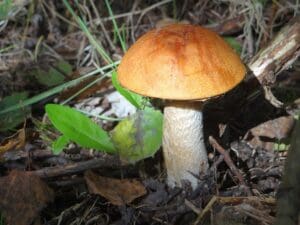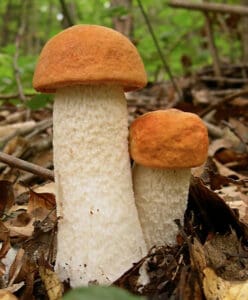Aspen Bolete / Summer / Autumn / Edible
The Aspen Bolete is really quite a rare find for me and I’ve mainly included it here because it’s the one thing you could possibly confuse for the Orange Birch Bolete, and although not an issue in anyway (you could quite happily pick it thinking it’s the orange birch bolete and process/eat in the same way with no issues).
It’s always nice to know what you’ve found.
Especially if, like me, you have a mushroom-foraging hit list of things you want to see in your lifetime.
Scientific Name
Leccinium albostipitatum
Family
Leccinium
Habitat
All Leccinum are ectomycorrhizal and most are specific to one tree species. The Aspen bolete grows with populus species especially Aspen-Populus tremula.
Rather rare species to find
Identifying Features of the Aspen Bolete
A tall polypore fungi with a bright orange cap, could be mistaken for an orange birch bolete but with a lighter stem.

Cap:
Terracotta orange 5-10 cm convex and remaining so into maturity. The cap can flake and overhangs the pores.

Stem:
White to cream with floccules, this is a feature of the Leccinium genus. Floccules are small raised areas on the stem, on the aspen bolete they can be white or a dark grey . The stem is very long 7-20 cm tall, often longer than the cap is wide and also very firm. On young specimens the stem is as wide as the cap. The long stem can taper slightly towards the cap and can curve slightly at the base.

Flesh
white, staining black when cut or exposed to air. The texture is very firm, making it resistant to bugs.
Underside (fertile)
This is a polypore fungi- 100s of Pores (tiny holes) on the underside of the cap which are off white in colour, and small.
Spores:
Olivaceous brown
Uses for the Aspen Bolete
In food
We recommend these be cooked for 15 to 20 minutes, as there are reports of people experiencing upset tummies if not cooked well. They also dry well so they can be used dehydrated in stews or powders to make mushroom sauces and stocks.
Harvesting
As they are quite rare we would suggest only collecting if you see multiple.Best harvested when young for taste and texture, the perfect size is if it can fit in the palm of your hand. but If you have a mushroom which is older but still good, you may want to discard the pores and tubes layer which peels away very easily, as the pores in particular can be soggy when older. You can simply peel them off and leave them in the woods.
Known hazards
There are reports of people experiencing upset tummies with this mushroom likely due to not being cooked properly. Certainly do not eat raw, and cook for 15-20 mins as mentioned above. As a precaution and something that should be exercised with all new fungi, try a little first to make sure you don’t experience reactions.
Potential lookalikes
No toxic look-a-likes
The Orange birch Bolete which as the name suggests also likes to grow with birch is very similar but with an orange brown coloured cap and darker spots on the stem. A great edible but has to be well cooked also.

Leccinum aurantiacum is also very similar and likes to grow with Populus and oaks. Can be used interchangeably
All Leccinum are edible, just the oranges one need to be well cooked.
Sources
Fungi of temperate Europe vol 1 by Thomas Laessoe and Jen H. Peterson





